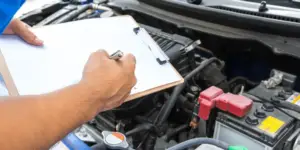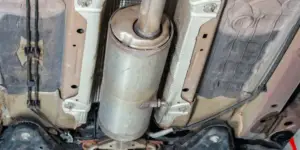People often assume the fuel pressure regulator is bad when other simpler causes and fixes exist.
In the article, we’ll list the tell-tale signs that your FPR is faulty, along with what else each sign could indicate.
In total, there are nine symptoms of a bad fuel pressure regulator. They are
- Engine Won’t Turn Over
- Engine Misfiring
- Sluggish Acceleration
- Humming Fuel Pump
- Decreased Fuel Efficiency
- Fuel Dripping From Exhaust
- Black Smoke From Tailpipe
- Gas in the Vacuum Hoses
- Sooted Spark Plugs
Let’s get into the details, starting with the most common first and finishing with the rare.
9 Bad Fuel Regulator Symptoms
1. Engine Won’t Turn Over
The fuel regulator allows the right amount of fuel into the engine at the right time. It can stick in either an open or closed position if it’s faulty. If it’s stuck in the closed position, no fuel will get into the engine to ignite and start the car.
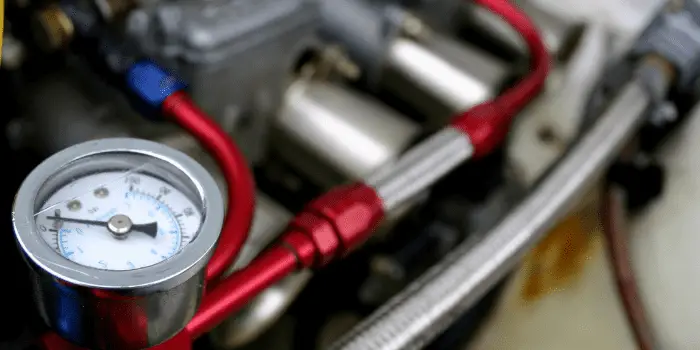
Other more obvious causes and cheaper fixes are:
If your car isn’t even trying to turn over, then the fault is more likely to be
- A dead battery
- Bad starter motor
If the car engine cranks but doesn’t fire, the fault is more likely to be
- Bad timing belt.
- Broken or cracked distributor cap.
- Bad ignition coil.
- Clogged fuel filter.
2. Engine Misfires
A bad fuel pressure regulator can cause a car to misfire, but unless you can say yes to other signs in this article, you can discard it as the cause.

It is far more likely that the problem is within the engine itself – and the combustion efficiency within it.
Other causes in order of likelihood
- Fuel injectors.
- Spark plugs
- Worn piston rings.
- Leaking head gasket.
3. Sluggish Acceleration
If your car’s FPR is not working correctly, it won’t allow the extra fuel through to the engine when you press down on the gas pedal.
This results in poor performance and could be dangerous if you need to quickly accelerate to get out of a bad situation – avoid other vehicles/accidents- on the road.
Other reasons in order of most likely first
- Clogged Air Filter
- Clogged Fuel filter
- Mass Flow Sensor clogged
- Oxygen Sensor malfunction
- Throttle Position Sensor bad
- Serpentine Belt slipping
Read Our Complete Guide To Fixes and Causes Of Cars Feeling Sluggish On Acceleration
4. Poor MPG
When the fuel pressure regulator gets stuck, it often can’t return the excess fuel that your engine doesn’t need to the fuel tank.
When this happens, the fuel stays in your engine and causes poor performance. This results in a poor MPG.
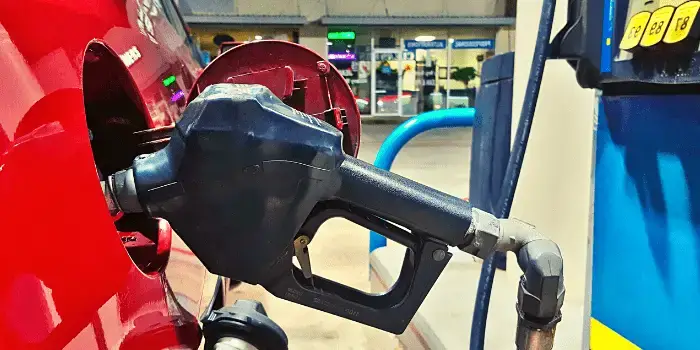
Other more common poor MPG reasons are :
- Engine is old – lack of compression in the cylinders.
- Cold weather reduces MPG
- Tire Pressure low – can knock off 5 MPG
- Frequent stops and starts
- A change in the Fuel Octane
- Bad Ignition Coils or Spark Plugs
5. Fuel Pump Noisy
A fuel pump always makes a noise even when working efficiently. Normally it’s a low humming noise. When a fuel pump -not the FPR – often fails, it makes a droning noise.
However, when the fuel pressure regulator is stuck, it can cause the fuel pump to whine loudly.
Other reasons the fuel pump makes noise are :
- Low fuel level – common reason. It has to work harder
- Water in the fuel
6. Black Smoke Coming From The Exhaust
When the FPR is stuck open, fuel enters the engine. The excess fuel can’t be burned and gets forced out of the exhaust, causing billowing black smoke.
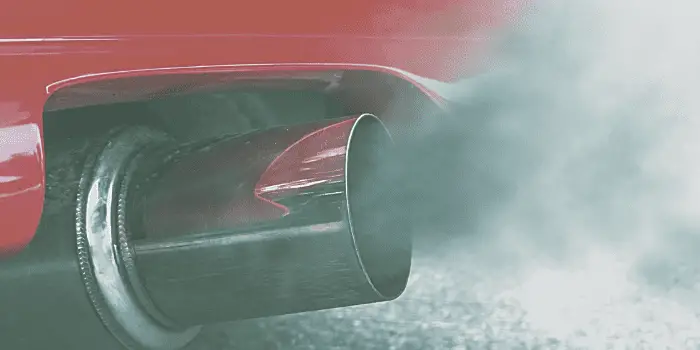
Other common black smoke reasons are :
- Fuel Injector(s) bad
- Air Filter clogged
- Blocked Intake Manifold
Why Does My Car Smoke At High RPMs? Blue, Black or White [GUIDE]
7. Fuel Drips Out Of The Tailpipe
In severe cases, the fuel doesn’t even get a chance to burn off partially and leaks out of the tailpipe. If you see this but no other symptoms, be sure it’s fuel.
If you’re noticing a rich fuel smell when you start your car in the morning and a clear liquid coming out of your tailpipe, be sure it’s not simply condensation being burned away.
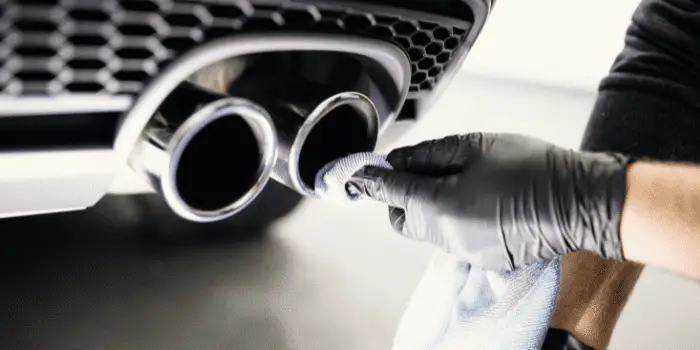
Obvious, perhaps, but a car will run rich when it’s first started. A fuel smell is common.
One other fuel in tailpipe reason :
- Spark plugs are bad and blow fuel out – rather than igniting it.
Two Checks that Involve Taking Things Apart.
8. Spark Plugs Are Sooted Up
Spark plugs normally last for approximately 50,000 miles before failing, but other faults that involve restricting the air entering the engine or too much fuel will clog them up and cut short their lives.
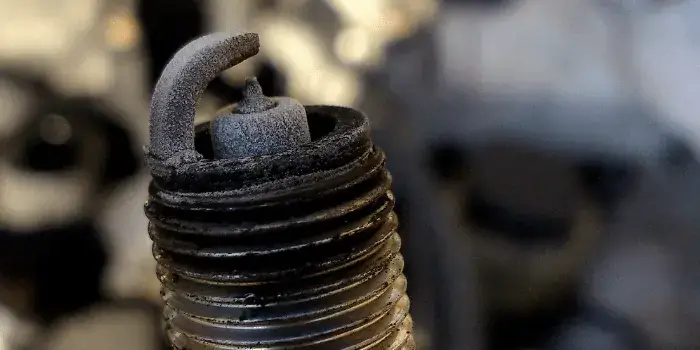
When the spark plug is called upon to burn more fuel than it can effectively, black soot forms around them, making the whole ignition system less efficient.
Other common reasons spark plugs go bad:
- Dirty Air Filter
- Idling for too long and shorter journeys. So not heating up enough
9. Gasoline In The Vacuum Hose
Gasoline doesn’t belong in the vacuum hose, period. If it’s there, then this does indicate a faulty FPR.
This is perhaps the one sign that on its own strongly indicates that it’s gone bad.
The other reason for gas in the vacuum hose:
- Fuel Pulsation Damper Seal (FPD) leak – its job is to smooth out the pulses caused by the fuel pump before the gas enters the engine. It can fail and occasionally cause gas to escape into the vacuum hoses.
In Conclusion
Many car faults have overlapping signs and symptoms.
If we add up the number of times other parts failing could be mistaken for a bad Fuel Pressure Regulator, we discover that the offending parts are likely to be in order.
- 1. Spark Plugs – possible in 4 out of the 9 symptoms discussed
- 2. Air Filter – possible in 3 out of the 9 symptoms discussed
- 3. Fuel Filter – possible in 2 out of the 9 symptoms discussed
- 4. Fuel Injector – possible in 2 out of the 9 symptoms discussed
It’s advisable that before wasting money on buying a new FPR, check to see if any of the four parts listed above could be the true cause.
Frequently Asked Questions
What’s The Cost of Replacing A Fuel Pressure Regulator?
A replacement fuel pressure regulator (FPR) part costs between $145 to $216. Labor fitting costs are between $85 and $99 depending on whether the part is located in the gas tank or on the fuel rail. Expect to pay between $230 and $330 in total.
Where Is The Fuel Pressure Regulator In A Car?
Depending on the make of the car, it’s found either in the fuel tank itself or mounted along the fuel rail close to the throttle body under the hood.
What is The Car Diagnostic Fault Code for A Fuel Pressure Regulator?
It is worth investing in an OBD-II fault reader before committing to changing any part. When plugged into your car, this device will read error codes that your ECU – car’s computer – has stored.

You may also have the engine light illuminated on the dash – but not always.
The error code that indicates a problem with your car’s fuel pressure regulator is P0089.





